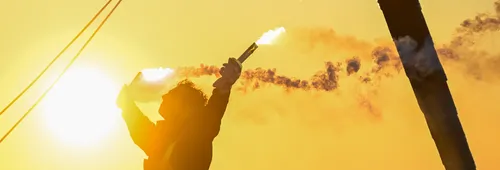A big depression will face the skippers from Briton Sam Goodchild (VULNERABLE) who is still four miles ahead of French rival (Jérémie Beyou) to 13th placed Sam Davies (Initiatives Coeur). It is forecast to bring winds of up to 50 knots in the gusts with big, unruly seas. It might yet prove the biggest test of their entire race, as has been the case many, many times in the 36 year history of the race.
Short of slowing down for several days – surely conceding days and places - there seems to be no real way of avoiding the system. The racers are going to have to face it head-on. Paul Meilhat (Biotherm) have a reminder recently that the North Atlantic in winter can prove even more testing than the Southern Ocean in the middle of the austral summer.
DEJA VU FOR CREMER
This weather pattern is said to be similar to the one that tested Maxime Sorel and Clarisse Crémer four years ago, “I must admit that I would have so liked it to be easier this time, but it is what it is. I have dreamed of a quiet finish, but that’s clearly not what’s on the horizon. The depression has slowed down, and now it's us that it's coming to bother us.” lamented the skipper of L'Occitane en Provence.
Naturally Crémer admits to being doubly envious of the trio already finished. “Right now it is all the more difficult not to be jealous of the first three. I don't know if they really know how lucky they were to have left the Indian Ocean!"
No easy way out
"Everything will actually depend a bit on the passage of this high pressure ridge and the timing when we come out of it. The depression is very deep. Are we going to find ourselves in front, in the middle or behind the front? It’s really hard to say,” explained Jeremie Beyou who was visibly tired, run down and frazzled speaking on the French Vendée LIVE! Show today.
The three times winner of La Solitaire du Figaro, who is in his fifth Vendée Globe and finished third in 2016, explained, “It continues to be complicated in terms of weather. We’re watching carefully what’s going to happen up ahead, and it’s pretty stressful. Everyone would like to find a path that’s passable. That’s the whole problem.”
Beyou who has had an auto pilot problem since early in the race and is on his back up added, “ Even when analyzing the situation from all angles, it’s complicated. The depression is particularly strong and the forecast is for a very rough sea. We’re talking about waves of 8 to 10 meters, or even more. It’s worrying. Yesterday, I managed to make routes towards Madeira, staying a little to the south-east. That reduced the strength of the wind quite a bit but especially the sea. Today this route seems less viable. "







